
Silphium is a genus of North American plants in the tribe Heliantheae within the family Asteraceae.

Arundinaria, commonly known as canes, is a genus of bamboo in the grass family.
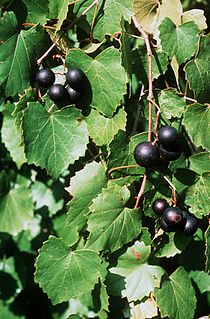
Vitis rotundifolia, or muscadine, is a grapevine species native to the southeastern and south-central United States. The growth range extends from Florida to New Jersey coast, and west to eastern Texas and Oklahoma. It has been extensively cultivated since the 16th century. The plants are well-adapted to their native warm and humid climate; they need fewer chilling hours than better known varieties, and thrive in summer heat.
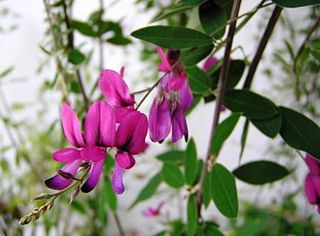
Lespedeza is a genus of some 40 species of flowering plants in the pea family (Fabaceae), commonly known as bush clovers or Japanese clovers (hagi). The genus is native to warm temperate to subtropical regions of eastern North America, eastern and southern Asia and Australasia.

Aristida is a very nearly cosmopolitan genus of plants in the grass family. Aristida is distinguished by having three awns (bristles) on each lemma of each floret. The genus includes about 300 species found worldwide, often in arid warm regions. This genus is among those colloquially called three-awnswiregrasses, speargrasses and needlegrasses. The name Aristida is derived from the Latin "arista", meaning "awn".

Desmodium is a genus in the flowering plant family Fabaceae, sometimes called tick-trefoil, tick clover, hitch hikers or beggar lice. There are dozens of species and the delimitation of the genus has shifted much over time.

Rudbeckia fulgida, the orange coneflower or perennial coneflower, is a species of flowering plant in the family Asteraceae, native to eastern North America.

Banksia splendida, commonly known as shaggy dryandra, is a species of shrub that is endemic to the southwest of Western Australia. It has sharply-pointed linear leaves that are woolly on the lower surface, cream-coloured and maroon or yellow flowers in heads of between 65 and 115, and later up to eight egg-shaped follicles in each head.
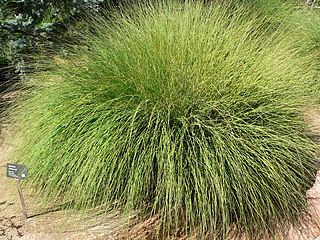
Muhlenbergia is a genus of plants in the grass family.
Luziola (watergrass) is a genus of New World in the grass family, native to North and South America including the West Indies.

Solidago speciosa, the showy goldenrod, is a North American species of flowering plants in the family Asteraceae. It grows in the province of Ontario in central Canada, as well as in the eastern and central United States.

Pycnanthemum is a genus of herbaceous plants in the mint family (Lamiaceae). Species in this genus are often referred to as "mountain mints" and they often have a minty or thyme-like aroma when crushed. All species of Pycnanthemum are native to the United States and Canada. The center of diversity for the genus is North Carolina with 13 of the 20 species having been collected therein. Nineteen of the 20 species of Pycnanthemum occur in the Eastern US and Canada, and one disjunct species occurs in California and Oregon.

Zenobia, called honeycup, is a North American genus of shrubs in the family Ericaceae.
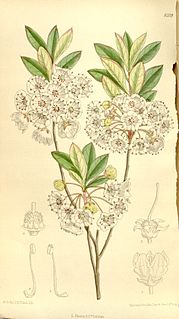
Kalmia cuneata is a species of flowering plant in the heath family known by the common name whitewicky, sometimes spelled white-wicky or white wicky. It is native to the eastern United States, where it occurs only in North Carolina and South Carolina.
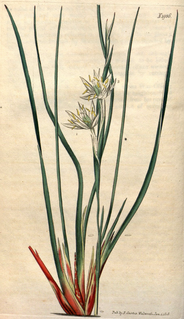
Pleea is a small genus of flowering plants described as a genus in 1803. There is only one known species, Pleea tenuifolia, the rush featherling, native to the southeastern United States.
Berlandiera pumila, the soft greeneyes, is a North American species of flowering plant in the family Asteraceae. It is native to the southeastern and south-central United States.
Bigelowia nudata, the pineland rayless goldenrod, is a species of North American flowering plant in the family Asteraceae. It is native to the coastal plain of the southeastern United States.
Lactuca graminifolia, the grassleaf lettuce is a North American species of wild lettuce. It grows in Mexico, Central America, Hispaniola, and the southern United States from Arizona to Florida, Virginia and the Carolinas.
Aristida dichotoma, known as churchmouse threeawn, fork-tip three-awn, pigbutt three-awn, and poverty grass, is a species of grass from eastern North America. It is native to the Eastern and Midwestern United States and Ontario, Canada. It has been introduced in California. It was described in 1803 by André Michaux.

Hypericum frondosum, the cedarglade St. Johnswort or golden St. John's wort, is a species of flowering plant in the St. John's wort family, Hypericaceae. It is native to the central and southeastern United States in dry, rocky habitats.














